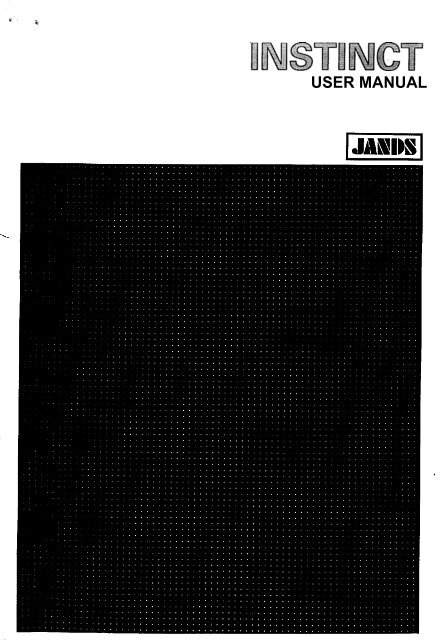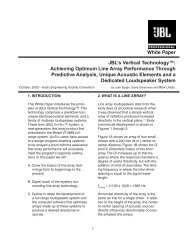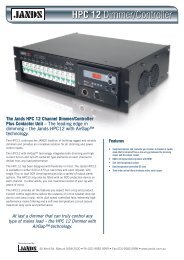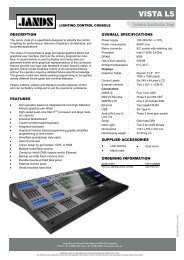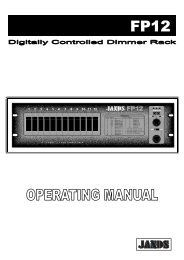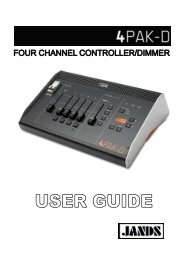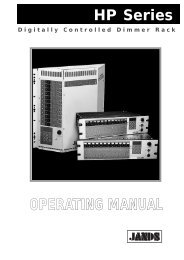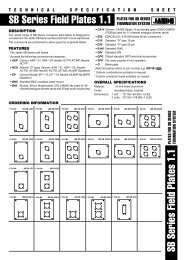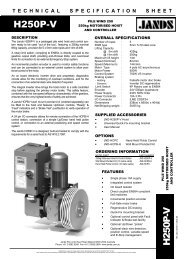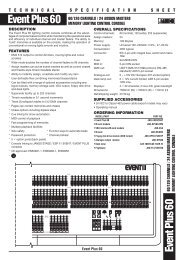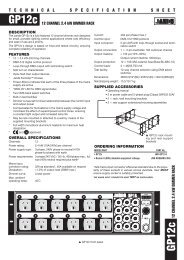You also want an ePaper? Increase the reach of your titles
YUMPU automatically turns print PDFs into web optimized ePapers that Google loves.
<strong>USER</strong> <strong>MANUAL</strong>
Contents<br />
SPECIFICATIONS ........................................................................................................ 1<br />
CONTROL REFERENCE ............................................................................................ 2<br />
FRONTPANEL ............................................ ..................................................... 2<br />
BACKPANEL.................................................................................................... 4<br />
MODE SELECTION..................................................................................................... .6<br />
RECORD....................... ...................................................................................... .6<br />
PLAY.................................................................................................................. .6<br />
SETUP............................................................................................................................. 7<br />
SETUP PROCEDURES.. .................................................................................. 7<br />
DESK LAMP INTENSITY.............................................................................. 7<br />
ANALOGUE OUTPUT POLARITY.. ........................................................... 7<br />
MEMORY ALLOCATION ............................................................................. .8<br />
SOFT-PATCH DIMMERS............................................................................... 8<br />
AUTO-INCREMENT ..................................................................................... .8<br />
FLASHINGCDRSOR..................................................................................... 8<br />
IN / OUT-FADE TIMES................................................................................. 8<br />
<strong>MANUAL</strong> CONTROLS.............................................................................................. 9<br />
PRESETS............................................................................................................ 9<br />
ADD/KILL BUTTONS.. .................................................................................. 9<br />
DEAD BLACKOUT (DBO). ............................................................................. 9<br />
GRAND MASTER........................................................................................... 9<br />
SCENES.......................................................................................................................... 10<br />
RECORDING SCENES.................................................................................... 10<br />
EDITING SCENES........................................................................................... .10<br />
BLIND RECORDING......................................................... .............................. 10<br />
PLAYING BACK SCENES.............................................................................. 11<br />
SWAPPING SCENE BANKS........................................................................ 11<br />
CHASES......................................................................................................................... 12<br />
RECORDING CHASES .................................................................................. .12<br />
PLAYING BACK CHASES............................................................................. 13<br />
EDITING CHASE STEPS ............................................................................... .13<br />
OUTPUT HOLD............................................................................................................ 15<br />
CROSSFADE ................................................................................................................. 15<br />
SOFTPATCH................................................................................................................. 15<br />
............................................................................................................................... 16<br />
MIDI & DESK LINKING............................................................................................. 17<br />
NOT USING MIDI or DESK LINKING ....................................................... 17<br />
LINKING TWO INSTINCT CONSOLES.................................................... 17<br />
MIDI RECEIVE.................................................................................................. 17<br />
Technical Notes for MIDI.............................................................................. .18<br />
M-CARD ........................................................................................................................ 19<br />
CLEARING MEMORY................................................................................................ 20<br />
Appendix A INSTALLATION................................................................................. 21<br />
Appendix B MAINTENANCE................................................................................ .22<br />
Appendix C TECHNICAL INFORMATION........................................................ 23<br />
<strong>Jands</strong> Electronics Pty Ltd<br />
578 Primes Highway<br />
St Peters 2044 Australia<br />
Phone (02) 516 3622<br />
Fax (02) 517 1045
JANDS INSTINCT Lighting Control Console<br />
SPECIFICATIONS<br />
Channels 48,60or72<br />
cenes 864 Maximum<br />
hasers<br />
OUTPUTS<br />
36 Maximum (864 Steps)<br />
Analog 0 to 10 volts DC<br />
Positive or Negative polarity<br />
Digital<br />
CONNECTORS<br />
RS485 standard<br />
USITT DMX-512 protocol<br />
Analog Out 2 x Bumdy 48 Pin Female<br />
2-3 x Socapex 337 Female<br />
or<br />
Digital Out 1 x Cannon 5 Pin Female<br />
Audio Trigger 3-pin Female AXR<br />
MIDI In/out<br />
DESK LAMP<br />
2 x 5-pin Female Din<br />
supply<br />
Lamp Type<br />
12v current limited<br />
2 x Littlelite 12G Hi<br />
Connector<br />
‘OWER<br />
2 x Cannon 3 Pin female<br />
Requirements 240 or 110 volts<br />
45 Watts (85 Watts w / analog outputs), 50 - 60 Hz<br />
Connector IEC<br />
Mains Fuse 2 amp 3AG<br />
DIMENSIONS (1 x d x h)<br />
48 Channel 1200mm x 530mm x 12Omm.<br />
60 Channel 1460mm x 530mm x 12Ornm.<br />
72 Channel<br />
WEIGHT<br />
1720mm x 530mm x 12Omm.<br />
48 Channel 20 kg<br />
60 Channel 22kg<br />
72 Channel 24kg<br />
Construction: 1.2mm steel front panel locked into aluminium<br />
extrusions and internal bracing panels to form a<br />
lightweight rigid chassis. Customwood end pieces.<br />
Finish: The front panel is one-piece reverse-screened Lexan to<br />
provide a durable tough finish. Switch caps are black<br />
with white hot-stamped lettering to indicate channel<br />
number or function.<br />
Access: The base can be removed after releasing the screw:<br />
holding it to the chassis. Two separate panels may then<br />
be hinged down to provide access to the Power Supply<br />
and all printed circuit boards. As high voltages arc<br />
present in the power supply, and there are no userserviceable<br />
parts inside the console, the base should<br />
not be removed by the user. Servicing should be<br />
strictly left to qualified personnel or service agents.<br />
1 User Manual V 2.2
JANDS INSTINCT Lighting Control ,Console<br />
.CONTROL REFERENCE<br />
FRONTPANEL<br />
1<br />
2<br />
6<br />
7<br />
8<br />
9<br />
10<br />
11<br />
12<br />
13<br />
Preset - There are two rows of preset faders which can be used to<br />
control the output of individual channels.<br />
Preset Master - These two sliders control the maximum level of their<br />
respective sets of Preset sliders. Under control of Grand Master.<br />
P1 Button - Add / Kill buttons for Preset 1.<br />
P2 Button - Add / Kill buttons for Preset 2.<br />
Scene Masters.- Each of these 24 sliders may be used to fade a prerecorded<br />
group of channels (a Scene) up or down. Under control of<br />
Scene Master.<br />
Scenes Grand Master - Controls the maximum level of the 24 Scene<br />
Master sliders. Under control of Grand Master.<br />
Add/Kill Button - These non-latching buttons are used to flash a<br />
Channel, Preset or Scene to the level set by the Add/Kill Master slider.<br />
When set to ADD, the selected output is added to the existing output<br />
of the console. When set to KILL, the selected output will flash to the<br />
level set by the Add/Kill master while blacking out or killing all other<br />
outputs.<br />
Add/Kill Master - Controls the maximum level of the Add/Kill<br />
function.<br />
Add/Kill Select Button - Swaps the Add/Kill buttons between the Add<br />
and Kill modes.<br />
Hold Button - Pressing Hold places the existing output of the console<br />
onto the Hold fader. A second press of Hold clears the hold memory.<br />
Output Hold Fader - This slider is used to control the level of the<br />
information stored in the Hold memory. Under control of Grand<br />
Master.<br />
Chaser A Master - Controls the maximum level of Chase A sequences.<br />
Under control of the Grand Master.<br />
Chaser B Master - Controls the maximum level of Chase B sequences.<br />
Under control of the Grand Master.<br />
2 User Manual V 2.2
I<br />
14<br />
15<br />
16<br />
17<br />
18<br />
19<br />
20<br />
21<br />
22<br />
23<br />
24<br />
25<br />
26<br />
Ch A Button - Chaser A One-Shot button. When pressed, the button<br />
will trigger Chaser A to run its programmed sequence once and then<br />
stop. The Chase Rate will be set by the Chaser A Rate slider. Note that<br />
this button acts in the same way as an Add/Kill button, when pressed<br />
the level of the chase will be controlled by the Add/Kill Master and in<br />
the Kill mode all other outputs will be blacked out.<br />
Ch B Button - Chaser B One-Shot button. When pressed, the button<br />
will trigger Chaser B to run its programmed sequence once and then<br />
stop. The Chase Rate will be set by the Chaser B Rate slider.<br />
Grand Master - Controls the maximum level of all level Masters<br />
except the Add/Kill Master.<br />
DBO Button- This Latching button (push on-push off) will disable all<br />
console output.<br />
Sample Button - Pressing this button stores the current desk output in<br />
memory as a Crossfade source.<br />
Cross Fade Button - Initiates the Crossfade which fades the sampled<br />
output to the selected scene output.<br />
Crossfade Rate Slider - This slider is used to manually override the<br />
crossfade rate. When in the centre position the fade-in and fadeout<br />
rates proceed at the rates set in the setup menu.<br />
Chaser Rate - This slider is used to control the speed of the Chaser. The<br />
Chaser will stop at minimum rate and can then be single-stepped by<br />
placing the cursor under “step”and using the Up/Down buttons.<br />
Go/Cue Button - Start/Stop control for the Chaser. When CUEd, the<br />
Chaser rate may be monitored and adjusted before pressing GO. This<br />
button will also cancel a one-shot chase.<br />
Fwd/Rev Button - Toggles Chaser operation between Forward,<br />
Reverse and Bounce.<br />
Display - The 48 character, backlit, Liquid Crystal Display (LCD) displays<br />
menus for Scene, Chase A, Chase B, Setup, and Softpatch as well as<br />
help messages.<br />
Cursor Keys (up, down, left, right arrows) - Moves the cursor around<br />
the various items on the menus displayed on the LCD<br />
Up Button - When pressed, will increment the number or function<br />
under the cursor in the Display. When held down, it will behave as a<br />
“fast-forward” button. When both Up and Down are pressed together,<br />
the number in the Display will reset to its minimum value.<br />
3 User Manual V 2.2
27<br />
28<br />
29<br />
30<br />
31<br />
32<br />
33<br />
34<br />
35<br />
36<br />
37<br />
Down Button - When pressed, will decrement the number under the<br />
cursor in Display. When held down, it wiII behave as a “fast- rewind”<br />
button.<br />
Full - This button allows values displayed in the LCD to be quickly set<br />
to their maximum value. It provides a convenient alternative to<br />
holding the up button pressed.<br />
Scene - Pressing this button accesses the Scene Menu which is<br />
displayed on the LCD. .<br />
Chase A - Enables the Operator to Record, Edit or Play Chase<br />
sequences.<br />
Chase B - Enables the Operator to Record, Edit or Play Chase sequences.<br />
Setup - Enables the Operator to set various INSTINCT parameters to<br />
cater for a particular job and personal preferences.<br />
Softpatch - Enables the operator to program patching information.<br />
Three separate patches may be programmed and stored in the Instinct.<br />
Midi - Pressing this button accesses the Midi Menu which is displayed<br />
on the LCD.<br />
Record - If pressed in the Chase or Scene menu the current desk<br />
output will be recorded. If pressed in the Edit Channel mode the<br />
contents of the edit buffer will be recorded. Record is also used to store<br />
a softpatch that has been altered.<br />
Help - To display help on the function of a button press “Help” then<br />
the button you need help with. If you need to know about something<br />
on the LCD place the cursor under it and press help twice. Help<br />
messages scroll automatically or can be accelerated using the down<br />
arrow key.<br />
Edit Chan - Allows editing of Channel levels in Scenes and Chases.<br />
Only available when SCENE, CHASE A or CHASE B are selected first.<br />
BACKPANEL<br />
38<br />
39<br />
40<br />
Mains Control - Inlet socket, 2 amp fuse and desk ON/OFF switch.<br />
Mode Select Switch - A key-switch to alternate the Operating Mode<br />
between Play and Record.<br />
Chaser Trigger - Will accept audio signals from microphone to line<br />
level. Chaser steps are then triggered from pulses derived from this<br />
input.<br />
4 User Manual V 2.2
41<br />
42<br />
43<br />
44<br />
45<br />
46<br />
Digital Output - 5 pin AXRconnector with digital multiplexed output.<br />
Conforms to USITT. DMX-512 Digital Protocol.<br />
Midi In/Out - Standard MIDI connection for communication with<br />
MIDI controller. Also used for, linking two, Instinct consoles.<br />
Interface RS 232 - Connection to allow communication between the<br />
console and a Personal Computer. This facilitates storing of INSTINCT<br />
information on floppy or hard disks, or programming on computer<br />
and then down-loading to the INSTlNCT.<br />
Link - -This connector is not currently used.<br />
Analogue Output (optional) - Burndy 48 pin or Socapex 37 pin<br />
connectors which provide discrete analogue outputs (0 to +/- 10 volts).<br />
M-Card Slot - Connection for an optional Memory Card. Used to<br />
backup information from the console..<br />
5 User Manual V 2.2
JANDS INSTINCT Lighting Control Consolc ‘,<br />
MODE SELECTION<br />
The INSTlNCT has two Operating Modes: PLAY and RECORD. It is<br />
possible to alternate between these two modes by use of the keyswitch<br />
which is located on the rear panel of the console.<br />
RECORD<br />
In the Record mode Scene, Chase, Setup and Softpatch recording is<br />
possible. In this mode all functions are available to the Operator. When in<br />
the record mode the display shows an r in the top left hand comer.<br />
PLAY<br />
The Play mode is indicated by a small p in the top left hand comer of the<br />
display. When the console is switched to play the operator is prevented<br />
from changing any recorded information. In the play mode it is not<br />
possible to:<br />
n re-record or edit scenes<br />
alter the chases in any way<br />
n alter anything in the setup menu with the exception of desk lamp<br />
intensity and crossfade times.<br />
change the selected softpatch<br />
The play mode can be used to lock out dimmers by softpatching their level<br />
to zero.<br />
6 User Manual V 2.2
JANDS INSTINCT Lighting Control Console<br />
When the Instinct is powered up for the first time the operator may wish<br />
to change some of the default factory settings which influence the way the<br />
console operates. However it is not necessary to change any of these<br />
settings in order to use the desk and many users will find the default<br />
setting suitable for their immediate use.<br />
The setup options available and their default settings are as follows:<br />
m Control desk-lamp intensity. 100%<br />
W Analogue output polarity Negative<br />
m Available. Scenes Banks 25 Banks (600 Scenes)<br />
W Available Chases. 12 Chases<br />
m Number of dimmers to Softpatch 200<br />
w Auto-Increment Scenes & Chase Steps On<br />
Crossfade In-fade and Out-fade times 1 Minute<br />
SETUP PROCEDURES<br />
To enter the Setup mode, press the SETLJP Function button. The Setup<br />
menu will appear on the LCD Disolav, as illustrated below:<br />
Desk Lamp Level:Full<br />
Total Banks: 25<br />
Since the Display can only show 2 lines at a time it is necessary to use the<br />
cursor 1‘ & 3. kevs to see the rest of the menu. Pressing the J key will reveal<br />
the rest of the menu as follows:.<br />
I Total Chases: 12<br />
Once the required option has been located the Up or Down Keys are used<br />
to change the setting. Note that using the cursor ?’ & J keys normally keeps<br />
the cursor under the setting to be changed. However when setting In fade<br />
or Out Fade times it may be necessary to use the t & 4 keys to locate the<br />
cursor under either the minutes or seconds setting.<br />
DESK LAMP INTENSITY<br />
The desk lamp intensity may be varied from zero to full (100) to allow the<br />
Operator to choose an optimum intensity for different ambient lighting<br />
conditions.<br />
ANALOGUE OUTPUT POLARITY<br />
The polarity of the Analogue Outputs may be set to either Positive (+) or<br />
Negative (-). This is to cater for certain dimmers that only accept single-
JANDS INSTINCT Lighting Control Console<br />
MEMORY ALLOCATION<br />
There is enough memory in the Instinct to store a total of 37 scene banks<br />
(each bank contains 24 scenes) and chases. A scene-bank is the same size as<br />
a chase so increasing the number of chases by one will reduce the number<br />
of scene banks by one and vice versa. To alter the scene bank to chase ratio:<br />
0 Ensure that the Mode Select switch on the back panel is set to the<br />
Record Operating Mode.<br />
Q Press Setup and place the cursor under Total Banks (or Total Chases)<br />
0 Use the Up Down Full buttons to alter the number.<br />
The ratio of scenes to chases can be set from 1 scene bank and 36 chases to<br />
36 scene banks and 1 chase.<br />
Each scene bank consists of 24 scenes and each Chase is made up of of 24<br />
steps.<br />
SOFT-PATCH DIMMERS<br />
The Digital output can be Soft-Patched before leaving the INSTINCT. This<br />
eliminates messy and tedious dimmer patch wiring at the dimmer racks.<br />
In the Setup mode it is possible to set the number of dimmers to be<br />
patched from 72 to a maximum of 200. However it does not matter if there<br />
are less dimmers used than this number indicates.<br />
AUTO-INCREMENT<br />
When Auto-increment is on, every time you record a Scene or Chaser<br />
Step - the scene number or chase step number in the Display automatically<br />
advances by one.<br />
FLASHING CURSOR<br />
Allows different cursor shapes to be used<br />
IN / OUT-FADE TIMES<br />
This allows the Operator to set separate In-fade and Outfade times. This is<br />
the time taken to crossfade with the Crossfade Rate slider in the middle.<br />
Enter a time from 1 second to 99 minutes 59 seconds.<br />
8 User Manual V 2.2
<strong>MANUAL</strong> CONTROLS<br />
PRESETS<br />
The PRESETS are the sliders that manually control individual channel<br />
output on the console. On the INSTINCT there are two rows of sliders<br />
which allow the operator to ‘preset’ different lighting looks and to fade<br />
between them. Each row of presets has a PRESET MASTER which<br />
determines the overall output level for all the sliders of that row. eg. if<br />
slider 12 is at 80% and it’s Master is at 50% then the output from Channel<br />
12 will be at 40%.<br />
ADD/KILL BUTTONS<br />
Pressing a channel Add/Kill buttons causes the individual Channel<br />
outputs to flash instantly to the level set by the Add/Kill Master slider.<br />
Pressing a scene Add/Kill buttons causes the Scene output to flash<br />
instantly to the level set by the Add/Kill Master. The Add/Kill Master is<br />
not controlled by the Grand Master slider. It is the only level fader that is<br />
independent of the Grand Master.<br />
If the Add/Kill Select in the Mastering section is set to ADD, then pressing<br />
an Add/Kill button will flash that Channel or Scene to the level of the<br />
Add/Kill master, and Add it to the console’s current output.<br />
If the Add/Kill Select is set to KILL, Then pressing an Add/Kill button will<br />
flash that Channel or Scene to the level of the Add/Kill master (as before),<br />
but it will blackout or kill all other console output.<br />
DEAD BLACKOUT (DBO)<br />
The DBO button is used to instantly kill all console output. It is a push-on,<br />
push-off button, and it’s LED indicates when the DBO is active<br />
GRAND MASTER<br />
This slider determines the overall output level for all controls on the<br />
Instinct except the Add/Kill buttons.<br />
9 User Manual V 2.2
JANDS INSTINCT Lighting Control Console<br />
RECORDING SCENES<br />
Ensure that the Mode Select switch on the back panel is set to Record.<br />
Press the Scene button and the display will show the Scene menu as<br />
illustrated below:<br />
1 Scene: 1<br />
Use the cursor buttons to move the cursor within the Display, and the<br />
Up/Down buttons to change the following settings:<br />
Set the Bank number (1 to 36 - depending on the setup configuration).<br />
Set the desired Scene Number (from 1 to 24).<br />
Set up the desired outputs for this Scene using the Presets or Scene<br />
Masters and press the RECORD button. The Display will show<br />
‘RECORDED” on the second line. If the Auto-increment is active (see<br />
section 4.5) the Display will update to the next Scene. Otherwise, press<br />
Up to set the Display to Scene 2.<br />
Set up outputs for the second and subsequent scenes and Record them<br />
as above.<br />
Remember that the Up and Down buttons will repeat if kept pressed. Also<br />
the Display can be made to reset to one by pressing Up and Down together.<br />
EDITING SCENES<br />
If the level of a particular Channel within a Scene needs to be altered<br />
(edited),<br />
Q<br />
Q<br />
0<br />
@<br />
0<br />
Ensure that the Mode Select switch on the back panel is set to Record.<br />
Press the Scene Function button and then the Edit Chan Function<br />
button.<br />
Using the Cursor and Up/Down buttons, select the Bank and Scene<br />
numbers.<br />
Select the Channel number and new level (0 to full)<br />
Press the Record button.<br />
If the altered Scene is not rerecorded, the changes will be ignored. In this<br />
way scenes can be altered on stage without necessarily being permanently<br />
stored.<br />
BLIND RECORDING<br />
If the scene master for the scene being edited is up (the scene is on stage)<br />
then the edit will be live and the operator will see the changes being made.<br />
If the scene master is at zero then it will be a blind edit.<br />
10 User Manual V 2.2
JANDS INSTINCT Lighting Control Console<br />
PLAYING BACK SCENES<br />
To play back a Scene, press the Scene function button. The LCD display<br />
will show “Bank xx”. Select the appropriate bank with the Up or Down<br />
buttons, and move the desired Scene Master slider, or press it’s Add/Kill<br />
button. The Scenes Master in the Mastering section controls the<br />
maximum level of the Scene Masters.<br />
It is possible to operate up to a full Bank of 24 Scenes simultaneously.<br />
SWAPPING SCENE BANKS<br />
It may be desirable to simultaneously use Scenes from different Banks, or<br />
to manually cross-fade from a Scene on one Bank to a Scene on another<br />
bank. This may be acheived using the Output Hold facility.<br />
Q<br />
8<br />
0<br />
Select a Scene and set it to the desired level.<br />
Press the Hold button. The Hold LED will turn on to show that the<br />
Hold facility is in use. Advance the Hold fader to maximum.The<br />
Scene Master slider can now be returned to zero, because the Hold<br />
slider now has control of the Scene.<br />
Leaving the Hold slider at maximum, select the Bank for the other<br />
Scene. The two Scenes may now be used together, or cross-faded by<br />
pushing up the new Scene Master slider to full while simultaneously<br />
pulling back the Hold slider to zero.<br />
An alternative method for scene bank swapping is to have a common<br />
scene recorded in both banks. The operator may have the last scene in each<br />
bank the same as the first scene in the proceeding bank.<br />
11 User Manual V 2.2
JANDS INSTINCT Lighting Control Console<br />
RECORDING CHASES<br />
The Chaser is used to automatically sequence through a pre-recorded<br />
series of “scenes” called STEPS. The operator can control the level, speed,<br />
and direction of the Chase sequence. Programming a Chase is similiar to<br />
the procedure described previously for scenes:<br />
Q Ensure that the Mode Select switch on the back panel is set to Record.<br />
Q Select either the Chaser A or Chaser B function button and the display<br />
will show. the chase (A or B)menu as illustrated below:<br />
Chase A:. 1 Step: 1<br />
Lenqth: 24<br />
Since the Display can only show 2 lines at a time it is necessary to use the<br />
cursor T & 4 kevs to see the rest of the menu. Pressing the J key will reveal<br />
the rest of the menu as follows:.<br />
1 Audio: Off Chase B OnlyI<br />
Chasemode:Sequential<br />
Attack Time: Off<br />
Decay Time: Off<br />
Next Chase: END<br />
Prior Chase: END<br />
Max Rate: 984 BPM<br />
Use the cursor buttons to scroll the Display, and the Up/Down buttons to<br />
change the following settings: _<br />
Set the Chase number (1 to 36 - depending on the setup configuration)<br />
and Step number .<br />
Set the desired chase length from 1 to 24 steps.<br />
Chaser B can be set to trigger from an audio input if required.<br />
Set Sequential or Random pattern.<br />
Setting attack time on lets the outputs fade up to full level over half<br />
the step time.<br />
Setting decay time on lets the outputs fade down to zero level over<br />
half the step time.<br />
Next Chase can be set to join the end of the current chase to the<br />
beginning of another chase<br />
Prior Chase can be set to join the beginning of the current chase to the<br />
end of another chase<br />
Set the maximum chase rate in beats per minute (BPM). The default<br />
(and maximum) setting is 984 BPM. This will be the chase speed with<br />
the rate fader set to 10. The fader can then be used to slow down the<br />
speed.<br />
Set up the desired outputs for the first Step using the Presets or Scene<br />
Masters and press the RECORD button. The Display will return to the<br />
first two lines and show “RECORDED” on the second line. If the Autoincrement<br />
is active (see section 4.5) the Display will update to Step 2.<br />
Otherwise, press Up to set the Display to Step 2.<br />
12 User Manual V 2.2
JANDS INSTINCT lighting Control Console<br />
@ Set up outputs for the second and subsequent steps and Record them<br />
as above.<br />
Remember that the Up and Down buttons will repeat if kept pressed. Also<br />
the Display can be made to reset to, one by pressing Up and Down together.<br />
PLAYING BACK CHASES<br />
To play a Chase sequence, press the Chase A or Chase B Function buttons<br />
and select the Chase number with the Up or Down buttons. Any Chase<br />
sequence can be assigned to either Chaser A or Chaser B - they both access<br />
the same memory. Select the speed of the Chaser with the CHASER RATE<br />
slider. The flashing red LED in the GO/CUE button indicates the Chaser<br />
rate.<br />
When the Chaser rate is correct, pressing the GO/CUE button will start the<br />
Chase sequence. The Chaser Master controls the output level of the<br />
Chaser. Pressing the GO/CUE button a second time will stop (Cue) the<br />
Chaser.<br />
If the Chaser is active, the Display will show the current Chaser Step<br />
number. If the Rate slider is then set to zero, the Up and Down buttons<br />
may be used to single-step the Chaser.<br />
The direction of the Chaser may be changed with the FWD/REV button.<br />
When the green FORWARD LED is on, the Chase will run from step 1 to<br />
the highest number step. When the red REVERSE LED is on, the Chase<br />
will run from the highest number step to Step 1. When both LEDs are on,<br />
the Chase will run from Step 1 to the highest number step and back to<br />
Stepl, and continue in this manner. This is called the BOUNCE mode.<br />
Pressing the FWD/REV button toggles it to the next mode.<br />
The Chasers also have a ONE-SHOT function. This is triggered by the CH<br />
A or CH B buttons in the Mastering section. When triggered, the Chase<br />
will sequence from Step 1 to the set Length and then stop. The Chase Rate<br />
slider determines the rate of the sequence. If the REV LED is on, the One-<br />
Shot will start at the highest Step and sequence backwards to Step 1. If<br />
Bounce is on, the One-Shot will sequence one complete forward and<br />
backward cycle.<br />
EDlTING CHASE STEPS<br />
If it is discovered that a particular Step in a Chaser is incorrect it may be<br />
edited as follows:<br />
Q Select Chase A or B;<br />
Q Select Chase number;<br />
0 Select Step number;<br />
@ Set up correct Channel outputs;<br />
8 Press Record button.<br />
13 User Manual V 2.2
JANDS INSTINCT Lighting Control Console<br />
It is also possible to edit particular channels using the Edit Chan Function<br />
button. First press Chase A or Chase B and then press Edit Chan. Use the<br />
Cursor and Up/Down buttons to select the Chase and Step numbers, and<br />
then select the Channel number and the new level. When all have been<br />
changed, pressed the Record button to store the changes in memory.<br />
Failure to do this will result in the changes being ignored.<br />
Press Chase A or B;<br />
Press Edit Chan;<br />
Select Chase number;<br />
Select Step number;<br />
Select Channel;<br />
Select new level;<br />
Press Record button.<br />
14 User Manual V 2.2
JANDS INSTINCT Lighting Control Console<br />
OUTPUT HOLD<br />
Pressing the Hold button will save the current console output onto the<br />
Hold fader. A second press will clear the Hold memory.<br />
Hold is useful when changing scene banks but may also be used as a third<br />
preset or to freeze a chase step.<br />
CROSSFADE<br />
A crossfade facility has been included to allow a smooth and repeatable<br />
fade-in/fade-out between two different scenes. To fade from a, current<br />
Scene to a new Scene, press the SAMPLE button. This stores the current<br />
console output in the Crossfade memory, the output is maintained by the<br />
Crossfade function and the Scene controls are disabled. A new Scene may<br />
now be selected.<br />
When ready to fade, press the X fade button. This starts the fade between<br />
the output as sampled and the new scene. The rate slider will override the<br />
X fade. With the slider in the middle, the fade will proceed at normal rate.<br />
When pushed to the top, the fade will accelerate, or when pulled to the<br />
bottom, the fade will stop. Separate in and out fade times can be set in the<br />
setup mode (up to 99 mins 59 secs).<br />
SOFTPATCH<br />
SOFTPATCH may be used to patch the INSTINCTS DMX-512 output to<br />
dimmers using this protocol or via a demultiplexer (such as the <strong>Jands</strong><br />
DDX 48) to normal analogue dimmers. This eliminates the need for a<br />
matrix or "spaghetti patch” at the dimmer racks, and allows the dimmers<br />
to be re-patched quickly and easily during a performance. Three different<br />
patches may be stored in memory as Patch 1, Patch 2 and Patch 3.<br />
It is important to note that patching is done by dimmer channel. Hence<br />
the dimmer to be patched is selected first then the desk channel to control<br />
it is chosen. A particular desk channel may be patched to any number of<br />
dimmers, but two or more channels cannot be patched to the same<br />
dimmer.<br />
To record or alter a softpatch:<br />
0 Ensure that the Mode Select switch on the back panel is set to Record.<br />
Q Press the Softpatch button and then display will show:<br />
Patch No: 1<br />
1 At:Full<br />
0 With the Cursor under Dimmer number select the dimmer to be<br />
patched. At this point changing the dimmer number with the<br />
Up/Down/Full buttons allows the operator to view the existing patch<br />
but does not alter it.<br />
15 User Manual V 2.2
0 With the Cursor under channel number the Up/Down/Full buttons<br />
will change the desk channel that is patched to the selected dimmer<br />
channel.<br />
0 With the cursor under the At level the proportional level of that<br />
dimmer is changed using the Up/Down/Full buttons.<br />
63 Press the Record button to save the changes.<br />
Note: All patch changes are live, it is not possible to record one softpatch<br />
while using another.<br />
HELP<br />
The help button gives two kinds of help. Firstly there is help on the<br />
INSTINCT button functions. Secondly there is help for the messages on<br />
the LCD. If you want to find out about a certain button, first press “Help”<br />
then that button. If you want to find out what a message on the LCD<br />
means, then place the cursor under it and press “help” twice.<br />
Help messages are generally bigger than can fit on one LCD screen. For this<br />
reason the text will automatically scroll after a short delay to the next page.<br />
Speedy readers can advance to the next page by pressing “down arrow”.<br />
16 User Manual V 2.2
MIDI-& DESK LINKING<br />
NOT USING MIDI or DESK LINKING<br />
When not using MIDI set MIDI mode (press the MIDI button to get to it) to<br />
off. This will prevent the MIDI-in socket from controlling the desk.<br />
When not linking two desks together set LINK ‘mode to NORMAL.<br />
LINKING TWO INSTINCT CONSOLES<br />
Desk linking allows two Instincts to be connected together and have<br />
common mastering, synchronized chases etc. Desk linking does not affect<br />
record and edit functions. These will have to be performed on each desk<br />
individually. The linking ensures that both desks are playing the same<br />
thing at the same time. Also the two desks still have separate outputs.<br />
To link a pair of desks:<br />
0 Connect the MIDI out of one to the MIDI in of the other. Do this again<br />
in the other direction so that both MIDI connectors on both desks are<br />
connected to the opposite type of MIDI connector on the other desk.<br />
Q Select the MIDI menu by pressing the MID1 button and the display will<br />
show the following menu.<br />
MASTER LINK Mode<br />
1 MIDI Channel I<br />
Since the Display can only show 2 lines at a time it is necessary to use the<br />
cursor ? & J keys to see the rest of the menu. Pressing the & key will reveal<br />
the rest of the menu as follows:.<br />
rzJzJ?J<br />
Use the cursor buttons to scroll the Display to LINK Mode.<br />
Q Set one desk into MASTER mode and the other into SLAVE mode.<br />
The master desk will now control the slave in the following functions:-<br />
- all 24 scene masters<br />
- the cross fader<br />
- the hold control<br />
- preset and chaser masters<br />
- the grand master<br />
- add/kill<br />
- chaser speed and direction<br />
Therefore the only controls on the slave desk that need be used are record<br />
and edit functions along with the presets themselves.<br />
If you want to use two linked desks with a MIDI input then you will have<br />
to remove the plug in the MIDI-in of the master desk and put the MIDI in<br />
here. The desk link is now taking place over only one cable. The removed<br />
cable made a kill on the slave desk cause a kill on the master desk so you<br />
will no longer have this ability.<br />
MIDI RECEIVE<br />
17 User Manual V 2.2
JANDS INSTINCT Lighting Control Console<br />
The MIDI input on the Instinct allows any MIDI device such as a keyboard<br />
or a sequencer to access and control the scenes and chases on the Instinct.<br />
Connect the MWI out on the device to MIDI in on the Instinct using a<br />
suitable cable.<br />
Select the MIDI menu by pressing the MIDI button and the display will<br />
show the Midi menu as illustrated below:<br />
I NORMAL LINK Mode I<br />
1 1 MIDI Channel I<br />
Since the Display can only show 2 lines at a time it is necessary to use the<br />
cursor T & & keys to see the rest of the menu. Pressing the J key will reveal<br />
the rest of the mend as follows:.<br />
Use the cursor buttons to scroll the Display, and the Up/Down buttons to<br />
change the following settings:<br />
0 Set MIDI channel to the MIDI channel your MIDI device is sending on.<br />
(1 - 16)<br />
@ Select MIDI mode on.<br />
The two MIDI machines are ready to talk. C (2 octaves below middle C)<br />
will start/stop chase A. The notes chromatically above that have the<br />
function listed in the table below. For the scene masters the note velocity<br />
corresponds to the scene master intensity.<br />
Note<br />
36<br />
37<br />
38<br />
39<br />
40<br />
41<br />
42-65<br />
Technical Notes for MIDI<br />
Function<br />
C Chase A Start/Stop<br />
C# Chase B Start/Stop<br />
D Chase A One Shot<br />
D# Chase B One Shot<br />
E Chase A single step<br />
F Chase B single step<br />
F# Scene masters 1 to 24<br />
Digital values (switches) use the convention of anon-zero velocity for<br />
switch on and a zero velocity for switch off. For analog values (levels) the<br />
velocity is the intensity (C-127). The Instinct MIDI interface uses only notes<br />
and velocities to transfer data. Note off is interpreted in the same way as<br />
note on with zero velocity. MIDI receive is in OMNI off/poly mode when<br />
normal link mode is selected. If either slave mode or master is selected<br />
then MIDI will be in OMNI mode On.<br />
18 User Manual V 2.2
M-CARD<br />
<strong>Jands</strong> INSTINCT Lighting Control Console<br />
It is possible to store all the information programmed into the INSTINCT<br />
on a compact memory card. The memory card (M-Card) may be used to<br />
safeguard data, transport information from one Instinct to another and<br />
expand the number of available scenes and chases. Recording or reading<br />
an M-Card takes less than 1 second.<br />
The procedure for using an M-Card is as follows:<br />
Insert the M-Card, screened side up, into the rear panel connector. The<br />
M-Card has an On/Off switch which must be in the ON position to<br />
allow Recording.<br />
Press the M-CARD function button<br />
The Display will now show:<br />
Press the ‘r (up arrow) cursor key to record information from the<br />
Instinct to the M-Card<br />
Press the .I, (down arrow) cursor key to record information stored in<br />
the M-Card to the Instinct.<br />
Depending on your choice you will be prompted as illustrated below to<br />
confirm the action.<br />
Write INSTINCT TO MCARD<br />
1‘ for YES J for NO<br />
z OR OR<br />
Read MCARD to INSTINCT<br />
T for YES 1 for NO<br />
8 Press the T (up arrow) cursor key to confirm the action<br />
@ Press the .I. (down arrow) cursor key to cancel the action.<br />
Remember that reading from an M-Card will erase all information<br />
currently in the Instinct and replace it with information stored in the M-<br />
Card.<br />
19 User Manual V 2.2
<strong>Jands</strong> INSTINCT Lighting Control Console<br />
CLEARING MEMORY<br />
There is normally no need to clear the entire memory of the Instinct. This<br />
procedure should only be used when information recorded in the console<br />
is no longer required.<br />
To clear the lNSTINCT memory hold down the Pl, P2, CHASE. A and<br />
CHASE B Add buttons whilst turning the desk power on. The Display will<br />
now show the following:<br />
Clear the Desk?<br />
t For Yes, &for NO<br />
I<br />
Pressing the ?’ key now allows the operator to proceed to clear areas of<br />
memory selectively. Pressing the 1 exits this operation.<br />
The next screen that appears in the display allows all scene and chase<br />
information to be erased:<br />
Clear Chases & Scenes ?<br />
,r For Yes, Jfor No<br />
The next screen that appears in the display allows all softpatch<br />
information to be erased:<br />
Clear the SOFTPATCH ?<br />
-r For Yes, Jfor No<br />
The next screen that appears in the display allows all setup information to<br />
be erased. Clearing the Setup information resets the factory defaults (see<br />
SETUP).<br />
I<br />
Clear the SETUP ???<br />
,r For Yes, Jfor No I<br />
After proceeding through these screens the display returns to show scene<br />
information.<br />
20 User Manual V 2.2
JANDS INSTINCT Lighting Control Console<br />
Appendix B MAINTENANCE<br />
The INSTINCT series has been designed to withstand the rigours of<br />
touring use. However, it may still be damaged by gross misuse. Note that<br />
the warranty does not cover damage of this sort. Protective road-cases are<br />
available for the INSTINCT series and are essential if the console is to<br />
travel extensively.<br />
Be careful not to spill liquids onto the Instinct. The lexan front panel<br />
provides a very durable surface but a cup of coffee entering the console<br />
through the slider cutouts will probably cause serious damage.<br />
It is usually. quicker and cheaper to double-check connections to the<br />
console before turning the power on, than it is to replace destroyed<br />
components and circuit boards. If in doubt, ask someone who does know.<br />
It is not necessary to use much pressure on the buttons or sliders. These<br />
will inevitably suffer if the operator is too heavy-handed.<br />
BACKUP BATTERY<br />
TROUBLESHOOTlNG<br />
If a system fault should become evident, try to isolate the source. ie<br />
dimmer racks, connecting cables, lighting desk, etc.<br />
Use any mimic LEDs to help isolate the fault.<br />
If the fault is traced to the desk, try to determine under what conditions<br />
the fault appears.<br />
Refer the desk to a JANDS service outlet for repair.<br />
There are no user-serviceable parts inside an INSTINCT.<br />
Servicing of an INSTINCT should be left to qualified technicians.<br />
22 User Manual V 2.2
Appendix C TECHNICAL INFORMATION<br />
TABLE A3.1-<br />
Bumdy No 1<br />
Channel Burndy<br />
1 A<br />
2 B<br />
3 C<br />
5 E<br />
6 F<br />
7 G<br />
8<br />
9 r”<br />
10 K<br />
11 L<br />
12 M<br />
13 N<br />
14 P<br />
15 R<br />
16 S<br />
17 T<br />
18 u<br />
19 V<br />
20 W<br />
21 X<br />
22 Y<br />
23 z<br />
24<br />
25 ;<br />
26<br />
27<br />
28 e<br />
30 g<br />
31 h<br />
3 i<br />
32 j<br />
33 k<br />
34 m<br />
35 n<br />
Earth t<br />
Earth .<br />
Earth .<br />
Earth aa<br />
TABLE A3.2 -<br />
Burndv No 2<br />
49 N<br />
50 P<br />
51 R<br />
52 S<br />
53 T<br />
54 u<br />
55 V<br />
56 W<br />
57 X<br />
58 Y<br />
59 2<br />
60<br />
61 :<br />
23 User Manual V 2.2
JANDS INSTINCT Lighting<br />
TABLE A3.3 - TABLE A3.4 -<br />
24<br />
TABLE A3.5 -<br />
19<br />
20<br />
22<br />
Ea21<br />
23<br />
32<br />
33<br />
34<br />
Earth 35<br />
Earth 36<br />
Earth 37<br />
User Manual V 2.2
25 User Manual V 2.2


